As the largest private real estate development in the United States, Hudson Yards is a project every New York development company would dream of having its name on.
At 18 million square feet, the Related Companies’ $20 billion development on Manhattan’s Far West Side will be larger than all of downtown San Diego.
But it’s not the only megaproject out there.
This month, The Real Deal looked at some other major developments across the globe, from Dubai to Paris to Shanghai, to see how Hudson Yards compares.
Some dwarf the 26-acre Hudson Yards in size, while others are not as big but are still expected to have an outsized impact, especially when it comes to easing overcrowding and improving infrastructure.
In addition, they are all redefining the real estate markets (and cities) they are located in — not to mention competing with New York and other international gateway cities for billions of dollars of global capital.
Paul Selver, a partner at the law firm Kramer Levin Naftalis & Frankel who co-chairs the firm’s land use department, said all megaprojects need three key ingredients: land, access to transportation and proximity to the center of the city. He also noted that some countries make it easier than others to go big.
“It’s also the nature of the government role in the process and how easy it is to put together an enormous megaproject when they don’t have the same due process that we have in New York,” he said.
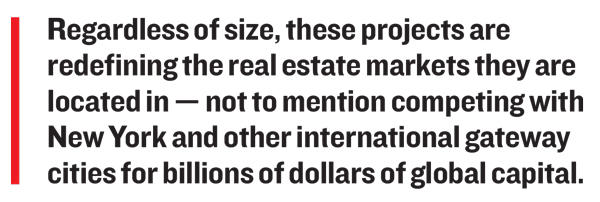
Heidi Learner, chief economist at commercial firm Savills Studley, said most of these global projects would not even be possible in New York.
“It just can’t be replicated in Manhattan because we are land-constrained,” Learner said, adding that they would not “necessarily work in the U.S.”
Dubailand
Dubai, United Arab Emirates
Dubai is already home to the tallest building in the world: The 2,722-foot-high Burj Khalifa, which dwarfs the tallest New York City skyscraper by more than 1,000 feet. But it could soon be home to the biggest entertainment complex as well. This 107-square-mile project is beyond the realm of even the most fantastical imaginations.
The development — which was pushed by the emir of Dubai, Sheikh Mohammed bin Rashid al-Maktoum — is a 20-minute drive from the airport and will include six theme parks devoted to things like eco-tourism, sports and retail, plus hotels and a large residential community.
Dubailand was announced in 2003, with a cost initially pegged at $64 billion.
But when the global financial crisis hit back in 2008, the project (which is reportedly twice the size of Disney World) was put on hold.
Construction resumed in 2013, but the scope was significantly scaled back. Dubai Properties, part of Dubai Holding, also took over from the original developer, Tatweer. The most recent news reports put the cost closer to $55 billion.
Dubai Properties completed the Miracle Garden portion of the project, billed as the world’s largest flower garden, with more than 60 million flowers, shortly after resuming construction. Last year, a 350-acre park, nearly as big as London’s Hyde Park, was announced.
A 2.2 million-square-foot retail and entertainment complex, dubbed Cityland Mall, is also in the works. The $330 million “nature-inspired” mall will include winding paths, footbridges and landscaping covering up to nearly 6 acres.
In early 2018, officials with Cityland Group, the developer, told Time Out Dubai that the firm expected the retail to be “fully committed” by the end of 2019’s first quarter. According to published reports, that space spans 1.2 million square feet with room for 350 retailers. By comparison, Hudson Yards will have about 100 retailers across 750,000 square feet. While financing figures for the full project have not been disclosed, in July developer GFH Properties announced that China Machinery and Engineering Corporation — a public company with a market cap of $15 billion on the Hong Kong Stock Exchange — would construct and finance up to 85 percent of California Village project, the residential portion of Dubailand, for $150 million.
A spokesperson for CBRE said the firm is advising a number of development clients in connection with the project.
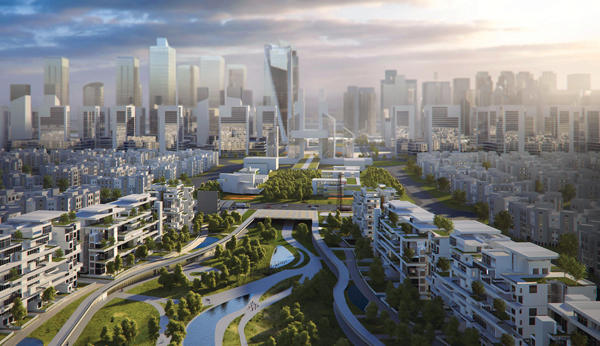
A rendering of New Cairo Capital, which will include housing for 6 million people
New Cairo Capital
Cairo, Egypt
Spread across more than 270 square miles, this project is one of the largest real estate developments on the planet. The government is spearheading the construction of an entirely new city — temporarily being referred to as the New Cairo Capital — as a measure to ease the population chokehold on its current capital, which is home to 23 million people. (By comparison, New York City’s population is 8.6 million.)
The new city, which sits in the desert 20 miles east of Cairo, will include housing for over 6 million people, 2,000 schools, 1,250 mosques and churches, 600 medical centers and a 5,000-seat conference center. Currently a giant construction zone, the city — which is expected to cover about as much land as Singapore — is being billed as Egypt’s first high-tech metropolis, and many hope it will draw international investment, which the ancient city of Cairo was not doing.
When it was announced in 2015, the Egyptian government, which is overseeing the project, said it would cost $45 billion and take only seven years to complete. But the total cost has yet to be fully tallied.
Egyptian President Abdel Fattah al-Sisi is scheduled to move his office to the city as early as June 2019, along with more than 30 government agencies, according to news reports.
The country has a lot riding on the project, which is being overseen by the Administrative Capital for Urban Development company, jointly owned by the Egyptian military and the country’s ministry of housing, Over the last decade, many in Cairo’s middle and upper-middle classes have moved to the suburbs, but glassy towers are now attempting to lure them (along with international buyers and investors) to the new city.
But at least one big deal has collapsed. In December, negotiations fell apart between Egyptian authorities and Chinese developer China Fortune Land Development Company, which had planned to spend $20 billion developing 15,000 acres of the city over the next 25 years. Egyptian authorities said the parties could not agree on how revenues would be split.
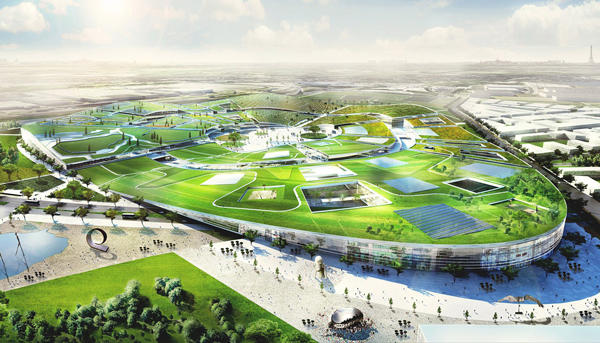
The 8.2-million-square-foot EuropaCity is under construction north of Paris.
EuropaCity
Paris and Berlin
On a much smaller scale, France is also trying to ease congestion in its capital and has begun building EuropaCity, an 8.2 million-square-foot mixed-use development just north of Paris.
The project’s master plan was designed by architect Bjarke Ingels’ firm, BIG — which in New York is responsible for Two World Trade Center, Via57 (the pyramid-shaped rental the Durst Organization developed along the West Side Highway) and HFZ Capital’s twin towers known as XI, among others.
A global architecture competition was held for the site’s eight main buildings, each of which seems to be more innovative and elaborate than the last. One hotel and kids’ cultural center is camouflaged into a hillside; another hotel is semi-transparent.
BIG’s overall plan calls for expansive landscaped rooftops in the shape of rolling hills, and walkways to imitate Parisian streetscapes. The site will include nearly 1.6 million square feet of retail, 540,000 square feet of cultural space, 215,000 square feet of restaurants, 2,000-plus hotel rooms, an urban farm and parkland — plus a new transit system.
Construction started on the $3.5 billion EuropaCity in 2013 and is expected to be complete in 2024. It is being developed by French firm Ceetrus and Chinese property development conglomerate Dalian Wanda Group, which until recently was a major U.S. real estate investor but is now unloading properties under pressure from the Chinese government.
The two firms also announced in December that they may eliminate plans for an indoor snow park after local residents and elected officials expressed concerns about its environmental impact, according to financial firm S&P Global.
To reduce its impact on local retailers, the developers are also considering rolling out the project in phases. The project is located between the center of Paris and Charles De Gaulle Airport and is expected to attract 31 million visitors a year.
In Berlin, another EuropaCity is being built. That one will contain 2,000 new apartments and over 4 million square feet of office, retail, school and promenade space. Construction started on the 100-acre site in 2014, and it is expected to be completed in 2025.
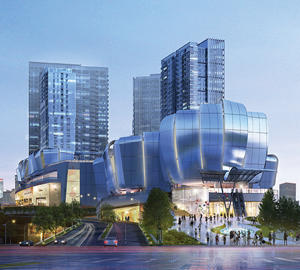
Like Hudson Yards, Todtown in Shanghai is being built over rail lines.
Todtown
Shanghai, China
Shanghai is also tight on space. As with New York’s Hudson Yards, the city is putting a site above existing railway lines to use.
Todtown, in Shanghai’s Minhang District, will contain almost 4 million square feet of mixed-use development, including a 1.4 million-square-foot mall and over 1,000 new apartments. The 49-acre site will also include hotel and office space.
The project is being built over Xinzhuang Station — a transport hub in Shanghai that serves two existing metro lines. A third line is being built, plus an express rail line. One key portion of the project is being designed by Chicago-based architecture firm Goettsch Partners and the Hong Kong firm Lead 8.
Renderings for the full site show 17 towers, including four taller buildings perched above an expansive shopping mall and a rooftop covered in greenery. It is expected to be completed by 2020.
The project is being developed by Hong Kong-based Sun Hung Kai Properties, a $42 billion conglomerate and one of the most valuable real estate companies in the world.
While the project is smaller than Hudson Yards, it is also expected to attract global tenants.
But Avison Young’s John Bralower, managing director of U.S. capital markets and global hospitality, said the development would not pose competition to Hudson Yards.
“I can’t think of that many situations when someone did something in New York and was doing the same in Shanghai,” Bralower said.
The two projects, he said, are “just so different.”
New City Istanbul
Istanbul, Turkey
Located on one of the few remaining areas of undeveloped land, New City Istanbul is being built in a former military zone, spanning 93 million square feet.
With more than 15 million people, Istanbul has been bursting at the seams. It’s also been marred by political unrest, including terrorist attacks and an attempted coup against the country’s President Recep Tayyip Erdogan in 2016.
That unrest — along with the plummeting Turkish lira — prompted real estate investors to pull out of deals there. A dispute between the Trump administration and Turkey that came to a head in August didn’t help matters.
At the time, Marcus Moufarrige, CEO of office provider Servcorp, told the New York Times that he walked away from a deal there when the landlords demanded U.S. dollars.
In 2016, the city council reportedly approved plans for the project, which will include 50,000 new residential units. The site will feature a nearly 27 million-square-foot public park and commercial space that includes a movie theater and ice rink.
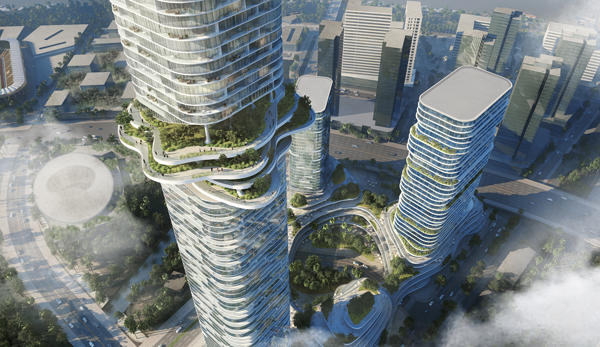
A rendering of Empire 88 Tower in Empire City
Empire City
Ho Chi Minh City, Vietnam
The architecturally remarkable Empire City is set to redevelop an impoverished area in Vietnam’s most populous city.
The 36-acre site in Ho Chi Minh City will include multiple towers, the tallest of which, Empire 88 Tower, will rise 1,093 feet.
Designed by renowned German architect Ole Scheeren, Empire 88 will be one of three towers emerging from a heavily landscaped base.
The Empire City project, on a peninsula overlooking the Saigon River, also includes a five-star hotel, a shopping mall and office buildings along with retail and restaurants.
In all, it will include 3,700 residential units starting at $260 per square foot, according to CBRE, which along with Savills is one of the firms marketing properties on the site. By comparison, 15 Hudson Yards currently has residential units listed for between $1,555 a square foot and $5,161, according to StreetEasy.
But not unlike Hudson Yards, the project is being billed as “a city within a city,” complete with co-working spaces and outdoor recreational areas.
It is being jointly developed by the Vietnam-based Tien Phuoc Real Estate JSC, Singapore’s Keppel Land, real estate private equity firm Gaw Capital Partners and Vietnam-based Tran Thai Real Estate Company.
For Empire 88, Scheeren has designed a cylinder-shaped, futuristic-looking tower. It will feature three levels of outdoor landscaping, nicknamed the Sky Forest, three-quarters of the way up the tower, along with a restaurant, among other amenities.
